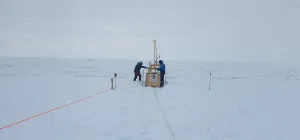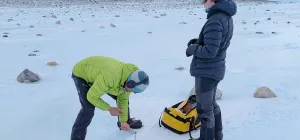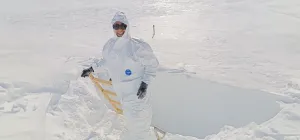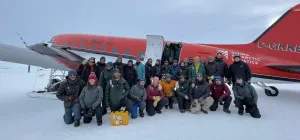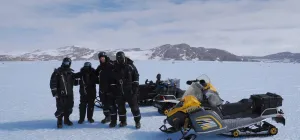I’ve come to appreciate ozone a lot more

The ozone hole over East Antarctica has been quite large during the austral spring, and Belgian journalist Jos Van Hemelrijck has felt its effects firsthand.
A treacherous beauty
Antarctica is beautiful, but treacherous. I've managed to hurt my eyes. Tears were streaming out continuously this morning, and the reason is obvious: taking off my sun goggles too often while taking pictures in this beautiful yet intense sunshine.
Although temperatures where down to more than -20°C yesterday and the day before, sunlight here can still easily burn the skin of our unprotected faces and hands. Dr. Alexander Mangold, the scientist from the Belgian Royal Meteorological Institute who’s measuring the composition of the atmosphere over Antarctica for the BELATMOS project, warned us that levels of harmful ultraviolet (UV) radiation are extremely high where we are. In fact, right above our heads sits what’s left of the infamous hole in the ozone layer.
Still a cause for concern
The ozone layer has the unique ability to screen out a large amount of UV radiation that comes from the Sun, protecting living creatures on the surface of Earth from their harmful effects, which includes damaging DNA in living organisms (a process that can provoke certain kinds of cancer like melanoma).
If the ozone layer over Antarctica was healthy, it would provide protection for my eyes and skin. But unfortunately it’s not. Although the 1987 Montreal Protocol banned the use of ozone-depleting aerosols like chlorofluorocarbons (CFCs), scientists estimate that it will still take several decades before CFCs are completely flushed out of Earth’s stratosphere. Recent studies indicate that the ozone hole over Antarctica is finally on the road to recovery. However the healing process has been very slow. So the hole in the ozone layer over Antarctica will continue to exist until CFC concentrations fall below a critical limit.
A bad time of year for ozone
During the Antarctic winter, temperatures 20 km above the surface of the Earth in the stratosphere, where the ozone layer lies, fall below -80°C. At this height and under these freezing temperatures, polar stratospheric clouds form. The ice crystals of these clouds act as catalyst for ozone destruction. When the first sunlight returns in Antarctica towards the end of the Antarctic winter, the harmful chlorine molecules from the remaining CFCs in the atmosphere are released, and this starts the cycle of ozone destruction.
By the end of September, the ozone hole over Antarctica reaches its maximum extent. When the stratosphere starts to warm up again in spring, ozone depletion tapers off and levels of ozone slowly rise again.
Protect yourself!
However as it’s only the end of November, ozone levels have not had much time to recover since winter. Alexander showed us yesterday's satellite image indicating how low ozone levels currently are above East Antarctica. The recently installed Brewer ozone spectrophotometer on the roof of Princess Elisabeth station measured very low quantities of atmospheric ozone.
"They are down to 180 Dobson Units,” Alexander said with a concerned frown. “I have seldom seen them that low.”
Ozone concentrations are measured in Dobson Units (DU). Over most parts of the planet, ozone concentrations are about 300 DU. With ozone concentrations at 180 DU over East Antarctica, the UV index reaches values as high as 8, meaning that unprotected skin burns within minutes.
“Better use lots of sunscreen!” he warned.
Download











